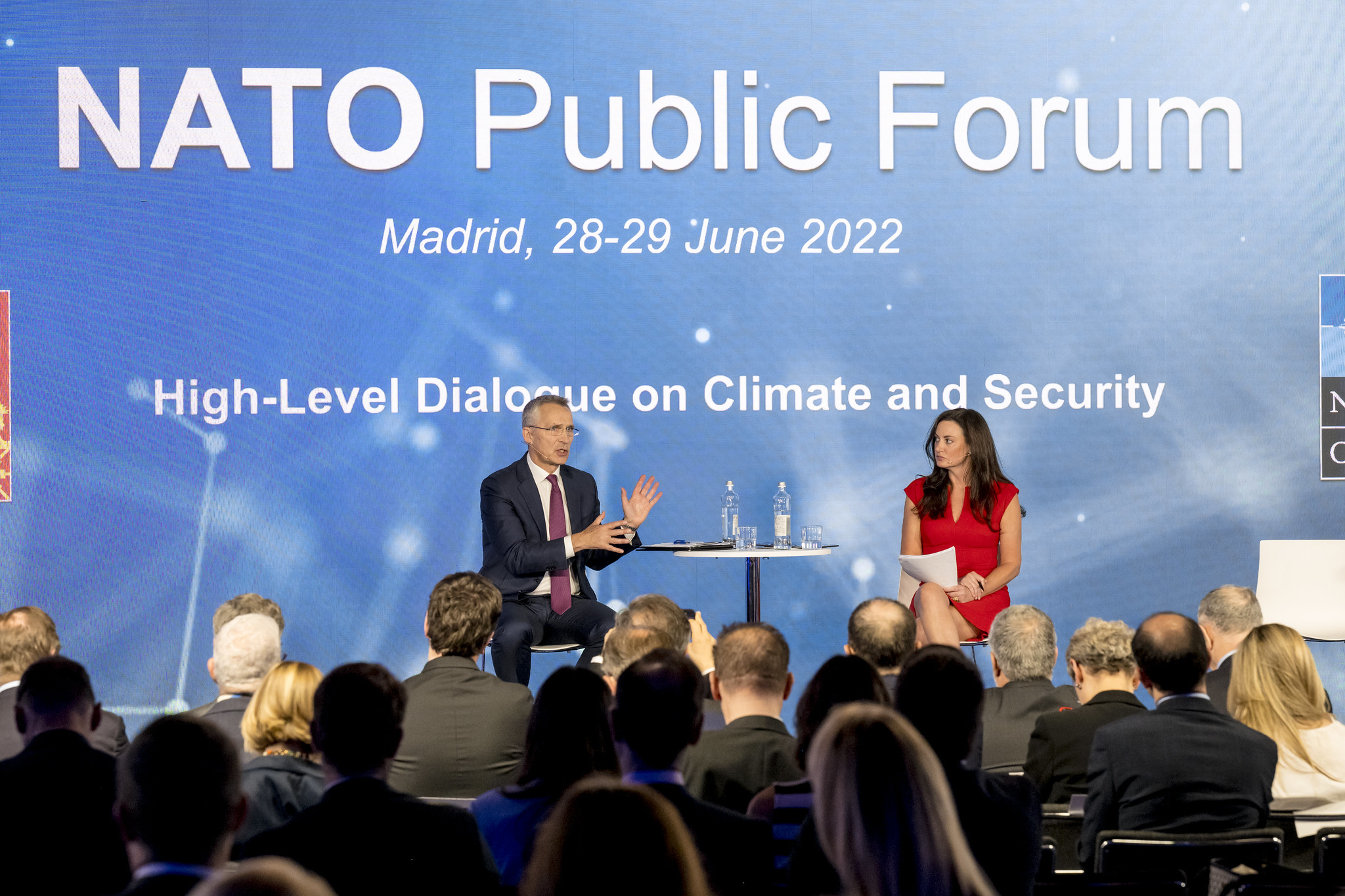Why NATO’s Focus on China and Its Climate Ambitions Might Clash

The decisions taken at the 2022 NATO Summit will provide new guidelines for NATO action in traditional and emerging security areas. By increasing its scope, the Alliance will have to make a concerted effort to balance its new list of priorities, including those that may come into conflict, such as climate change action and its new China policy.
This article is part of a series of articles authored by young, aspiring China scholars under the Future CHOICE initiative.
The 2022 NATO Summit held in Madrid concluded with key decisions to transform and strengthen the Alliance. Although the discussions focused largely on Russia, the adoption of a new Strategic Concept also provided an opportunity to include other non-traditional, or otherwise new, security threats in NATO plans. The need to address these challenges had also been explicitly stated in the five-point agenda of the summit, listing terrorism, cyber-attacks, Chinese coercive practices, disruptive technologies, and climate change as the key new threats.
The expanding focus of NATO, however, creates new challenges for the Alliance in balancing the different priorities. In particular, NATO’s involvement in climate change mitigation — an area that will likely necessarily involve cooperation with China — and developing a strategy to deal with the security challenges posed by China, could potentially come into conflict.
In the 2022 Strategic Concept, NATO took care to differentiate between Russia, which is openly labeled as hostile and aggressive, and China, which is described as a source of “systemic challenges.” Nonetheless, the newly-found focus on the challenge posed by China was clear in Madrid. For the first time, NATO invited key Indo-Pacific partners to the summit due to intensifying concerns about China’s ambitions in the region. Chinese policies were also described as coercive and counter to NATO values and interests, with Beijing aligning instead with Russia in its attempts to subvert the current world order.
As for climate change, the new Strategic Concept recognizes it as a “defining challenge of our time with a profound impact on Allied security,” and NATO commits to “integrate climate change consideration across … core tasks.” In Madrid, NATO leaders agreed on various strategies to fight climate change, including emissions targets that will guide the Alliance’s path to carbon neutrality by 2050, in line with NATO’s 2021 Climate Action Plan.
NATO’s Climate Security Agenda
In recent years, climate security has become a growing concern. NATO, the world’s largest military alliance, already acknowledged climate change as having “the potential to significantly affect NATO planning and operations” in its 2010 Strategic Concept. The Alliance has explicitly underlined climate change as a threat multiplier and a shaping threat, referring to the impacts of the increasing number of extreme climate events on the environment in which the Allied forces operate.
NATO’s approach to climate change has since been more explicitly defined, particularly via the Action Plan endorsed at the 2021 Summit, held in Brussels. The Plan is composed of three key action points. Firstly, the Alliance aims to increase issue awareness by carrying out and publishing annual assessments of the link between climate change and security. Its second goal is to participate in the reduction of emissions by mitigating those resulting from military activities, while keeping armed forces at full capacity. Lastly, NATO also intends to adapt its armed forces to the impacts of climate change, enabling them to operate in more extreme climate conditions. The Action Plan further committed NATO to strengthening collaboration with other international and regional organizations, as well as partner states that are active in climate change and security issues.
Under the Shadow of US-China Relations
Although there is a general consensus that climate change is a global concern, there is a clear tendency to link specific actors to the issue. China, as the world’s main CO2 emitter and an increasingly active participant in international climate governance, is high on that list. At the same time, China is also a rising point of concern for NATO who, in the same Communiqué where its members endorsed the Action Plan, declared China to be a strategic competitor. In a recent interview with POLITICO, NATO Secretary General Jens Stoltenberg further explained that the Alliance is concerned by China’s expansion of its nuclear arsenal and related key technologies and its attempts to secure influence in critical infrastructure abroad. The Communiqué also lists Sino-Russian cooperation as a cause for concern.
Beyond NATO’s position as a bloc, its engagement with China is also conditioned by the worsening US-China tensions, given the influence the US holds within the NATO structure as one of the biggest contributors to its budget and the NATO member with by far the largest active military. Although other members of the Alliance have also produced their own China strategies, the US in particular has been pushing NATO to do more about China, reflecting its own geostrategic shift to the Indo-Pacific. Whereas the previous version of the NATO guidelines did not mention China, Washington was the key actor in pushing for defining NATO’s role regarding China in the new Strategic Concept.
Climate, on the other hand, is lower on the US list of priorities within the NATO framework: given the Alliance’s scope and resources, some US voices have argued that climate issues should be left to other international fora. Accordingly, although the US has expressed support for acknowledging climate change in the new Strategic Concept, it may wish to limit NATO’s involvement in addressing the issue within the immediate military dimension.
Balancing China and Climate Change
Against this background, NATO’s choice to, according to the 2021 Communiqué, maintain constructive dialogue and “engage with China on areas of relevance to the Alliance and on common challenges such as climate change” seems encouraging, especially given China’s relevance to all three sections of NATO’s climate Action Plan.
Regarding the climate change and security reports, the recent publication of the first of these annual assessments indicates that NATO climate activities must take into account the importance of avoiding strategic dependencies on China while transitioning to clean technologies, given the Asian giant’s predominance in the extraction and processing of essential materials. However, there are also reasons for NATO to support Chinese efforts in the development of renewable energy, as it may reduce China’s dependency on imported fossil fuels and, therefore, both its emissions and its need to continue expanding its regional military presence in order to ensure energy security.
In terms of reducing military emissions, NATO has repeatedly underlined that its aim is to achieve this goal while keeping forces at full capacity, in the face of not only the current Russian aggression, but also Chinese military and nuclear proliferation. Nonetheless, although China possesses significant military capabilities, and its missile arsenal, in particular, is noticeably broad, varying from short-range systems to intercontinental ballistic missiles, the US and its allies retain a significant advantage in nuclear capabilities. China has not published official data on its stockpile, but recent estimates are mostly between 200 and 400 warheads. This pales in comparison to the US’ inventory of almost 6,000 nuclear warheads, of which more than half are ready for deployment. NATO thus has a certain leeway for emissions reduction to temporarily require a small decrease of available forces while still maintaining military primacy vis-à-vis China.
Lastly, when it comes to adapting NATO to increased climate challenges and natural disasters, dialogue with China could prove particularly valuable. China has built up significant expertise in natural disaster risk reduction, given that climate change continues to exacerbate the frequency and intensity of such disasters within its borders. In particular, insights on how China achieved its shift from reactive to proactive disaster reduction and mitigation measures could in particular be interesting for NATO operations. Collaborating on this subject would also be in line with NATO’s commitment to strengthen cooperation with other states and bodies that are active in climate security issues.
However, even if climate cooperation holds significant potential, it remains to be seen whether it will be overshadowed by the growing tensions stemming from NATO’s concerns about China’s backing for Russia as well as China’s alarm about the US and its allies stepping up their security engagement in the Indo-Pacific. Reconciling climate cooperation and geopolitical competition will require a careful balancing act which, if unsuccessful, could leave the world hard-pressed to effectively address climate change.
Written by
Blanca Marabini San Martín
BlancaMSMBlanca Marabini San Martín is a PhD student at the Centre for East Asian Studies of the Madrid Autonomous University (CEAO – UAM), in Spain, as well as part of the China Horizons Research Consortium. She has collaborated with the International Institute for Asian Studies (IIAS, Leiden), the Spanish Institute for Strategic Studies (Ministry of Defense of Spain), and the Spanish Chinese Policy Observatory. Her research interests center around the climate, environmental, and green tech dimensions of China’s foreign policy, particularly within the framework of EU-China relations.


